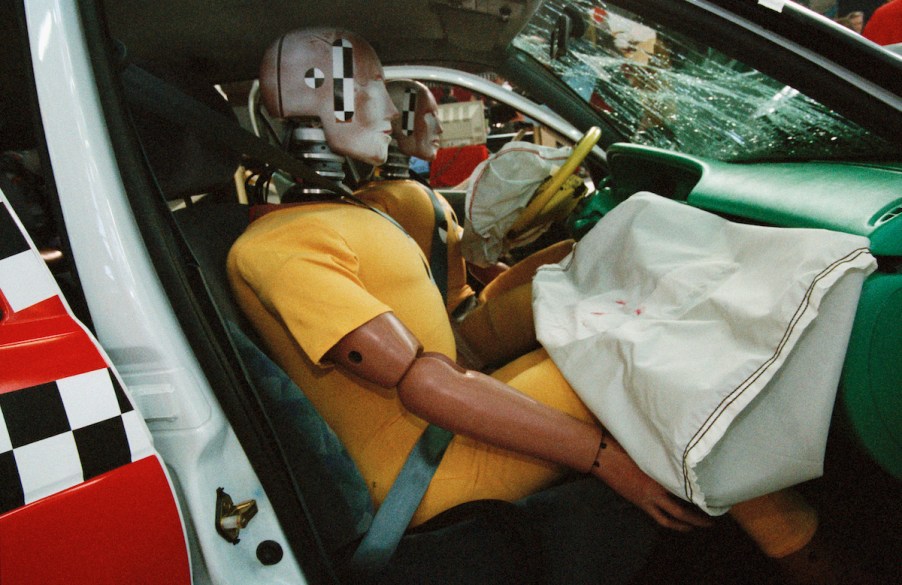
IIHS Plans to Increase the Difficulty in Vehicle-to-Vehicle Crash Tests
Safety is a priority when buying a new vehicle. But if many of today’s vehicles score well on tests from the Insurance Institute for Highway Safety (IIHS), how can consumers tell which vehicle is best? The IIHS has recognized this problem. The organization recently updated its side-impact crash test and is considering updating a second crash test too. Making the testing more difficult also pushes manufacturers to improve car safety.
What is the IIHS?
The IIHS is a nonprofit that uses research and education to reduce the deaths, injuries, and property damage caused by vehicle crashes. It’s a good source of information for consumers interested in comparing the safety ratings of various vehicles.
The IIHS has six tests that examine a vehicle’s crashworthiness: moderate overlap front, driver-side small overlap front, passenger-side small overlap front, side, roof strength, and head restraints and seats. In addition, the IIHS also tests prevention systems, seat belt reminders, headlight systems, and LATCH child seat attachment hardware.
All of those ratings help the IIHS determine its Top Safety Pick+ and Top Safety Pick awards for each model year. For the 2022 model year, vehicles earn a Top Safety Pick by receiving the highest rating of Good in the six crashworthiness tests, plus Advanced or Superior ratings for front crash prevention in both vehicle-to-vehicle and vehicle-to-pedestrian crashes and Acceptable or Good ratings for available headlights.
In addition, Top Safety Pick+ award winners have standard headlights that are rated Acceptable or Good.
The IIHS’s vehicle-to-vehicle front crash prevention test

One IIHS test is set for an update. The vehicle-to-vehicle front crash prevention test creates a simulation of a vehicle hitting another vehicle that is stopped on the road. Since 2013, the IIHS has run this test at 12 mph and 25 mph, and 85% of 2022 vehicles that the IIHS tested earned a rating high enough to qualify for Top Safety Pick+, Car and Driver reports. Vehicle-to-vehicle front crash prevention test ratings are based on how the vehicle does at both speeds and whether a forward-collision warning system is available.
The IIHS gives a Superior rating in this category to vehicles with an autobrake system that can avoid a crash or “substantially reduce speeds” at both test speeds. An Advanced rating is earned by vehicles that have an autobrake system that can avoid a crash or reduce the speed by 5 mph or more at one of the two speeds. A Basic rating is for vehicles that have a warning system only and meet the performance criteria of the National Highway Traffic Safety Administration (NHTSA).
The success of current vehicles is in part due to the inclusion of automatic emergency braking (AEB) systems in most light-duty vehicles, which auto manufacturers added as part of a voluntary agreement with the IIHS and the NHTSA.
The IIHS’s director of media relations, Joe Young, told Car and Driver: “The automaker commitment to fit AEB as standard equipment will go into effect at the end of this year [2022] and the performance requirements for that commitment are based on our current tests.”
He also pointed out that “the commitment is making the current test obsolete. The commitment is a big win for consumers, who won’t need to shop for a specific trim line or package to get this proven safety technology on their next new vehicle. And a new test, when it’s launched, will help push the technology even further.”
The IIHS’s plan to increase test speed limits to enhance safety
The IIHS is considering changing the speed range to between 35 and 45 mph, which is closer to more real-world scenarios. The organization looked at police reports for rear-end crashes and found that only 3% occurred at less than 25 mph. The IIHS also found that 43% were at less than 45 mph, as were 12% of fatal rear-end crashes.
The institute plans to try new speeds for the test this summer. Because it will take some time to update the process, the change will not affect the 2023 Top Safety Pick winners. The IIHS recently updated its side-impact crash test, and the vehicle-to-vehicle update will follow a similar process. Both updates make it easier for consumers to differentiate among models and give manufacturers an incentive to continue improving car safety.
The IIHS’s tests have encouraged auto manufacturers to improve the safety features in their vehicles. Increasing the difficulty of the vehicle-to-vehicle crash prevention test will raise the bar and lead to even safer cars.


